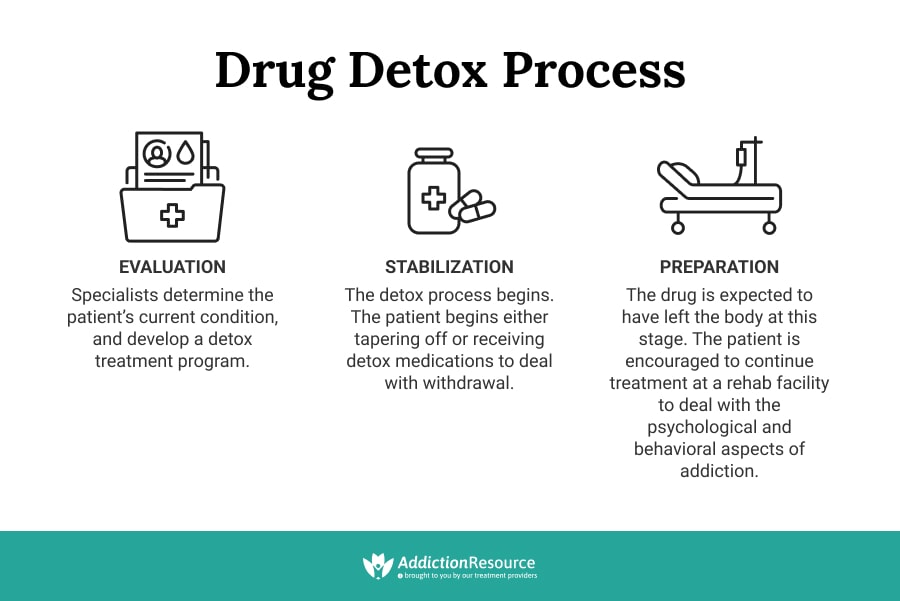Detox has become a topic in the beauty industry often advertised to promote “miracle detox diets” for weight loss or better skin.
Yet, for people dealing with substance abuse, undergoing supervised drug detox can be a life-changing decision as it marks an initial step toward recovery. Fortunately, data from the 2021 National Survey on Drug Use and Health (NSDUH) shows that of the 29.0 million adults who experienced a substance use problem, 20.9 million have either recovered or are in the process of recovery.
These statistics highlight that seeking help is paramount for successfully overcoming addiction, with detox at the heart for safely managing the substance absence aftermath. If you or someone you know is struggling with addiction, read on to learn more about how substance detox works, the process and where to get it.
Table of Contents:
What is Drug Detox?
As the medical field considers addiction as a brain disorder potentially altering stimuli pathways in the brain, people facing substance dependence may have a difficult time safely quitting drug use. Several treatments are available to manage the recovery process safely and substance detox is one of them.
Also referred to as medically supervised withdrawal, detox is a therapeutic approach used to treat the acute withdrawal symptoms caused by reducing or discontinuing substance use. Even though medical detox is not considered a sufficient treatment itself, it frequently provides a first point of contact for additional options for longer-term abstinence, such as medication, individual counseling, or rehabilitation.
4 Types of Drug Detox
Addiction disorders vary based on the drug used, how long it is used, and a person’s past medical history. These variables determine the course of the substance detox. Over the years, medical professionals have worked diligently to offer innovative detox options.
The available medical detox options include:
Medical Detox
Using medications to control the symptoms of withdrawal depends on the substance and severity of the symptoms. For example, in patients with alcohol dependence already suffering the most extreme forms of withdrawal, which are seizures and/or delirium, the administration of the medication should be carried out as soon as possible.
In some cases, individuals with substance dependency are hospitalized for other health issues and may require hospital-based detoxification even if they weren’t seeking substance addiction therapy. Medical drug detox can be done in inpatient facilities and is mainly limited to those with severe drug addictions.
Rapid and Ultra-Rapid Detoxification
The rapid or ultrarapid methods were designed to make the detoxification process shorter and easier.
During rapid substance detoxification, the patient is put under anesthesia and given medication to initiate the withdrawal process. The aim is to maintain the patient sedated until the withdrawal symptoms subside. However, warnings have been issued regarding the safety of this method.
Common narcotics antagonists such as naloxone, naltrexone, or nalmefene are used to induce narcotic withdrawal by displacing external opioids from receptor sites, promoting the detoxification process. Although this type of drug detox was widely used in the 90’s, there are no controlled trials to assess the risk/benefit ratio. The rapid and ultra-rapid detoxes are still disputable.
Outpatient Detox Programs
Those with less severe dependence and stable homes can undergo detoxification while living in their own homes. Medical professionals perform regular check-ins to monitor progress, adjust treatment plans, and provide guidance.
Social Detox
Social detox programs serve as short-term, nonmedical treatment services for people with less severe substance dependencies that do not require intensive medical supervision. These detox programs can greatly vary in approach and scope.
Social drug detox programs differ in supervision levels, from on-site medical support to access through clinics, ‘cold turkey’ detox, or supervised medication. Regardless, these programs prioritize addressing psychological aspects, offering counseling, therapy, and peer support.
Drug Withdrawal Symptoms
Similar to the way substances cause different stimuli in people so do withdrawal symptoms. Each substance has a withdrawal profile that can vary in severity and between individuals. Withdrawal symptoms present in the most common addictive substances include:
| Substance | Withdrawal Symptoms |
|---|---|
| Alcohol | Anxiety, tremors, nausea, sweating, irritability, insomnia, hallucinations, seizures (in severe cases). |
| Marijuana/THC | Irritability, insomnia, loss of appetite, mood swings, restlessness. |
| Opioids | Nausea, vomiting, muscle aches, anxiety, insomnia, yawning, diarrhea, sweating, dilated pupils. |
| Sedatives | Anxiety, tremors, insomnia, seizures (in severe cases), irritability. |
| Stimulants | Fatigue, depression, increased appetite, disrupted sleep patterns, irritability. |
| Inhalants/Solvents | Nausea, headaches, dizziness, irritability, muscle weakness, tremors. |
| Nicotine | Irritability, anxiety, restlessness, increased appetite, insomnia. |
| Hallucinogens | No significant physical withdrawal; psychological symptoms may include mood swings, flashbacks or anxiety. |
3-Step Drug Detox Process
Providing a safe discontinuation from a substance of dependence is one of the main objectives of detox. Detoxification typically takes a few days (7 days) to a few weeks, depending on the substance, the level of dependence, and the patient’s access to assistance.
Health professionals should carefully follow the following steps:

-
Evaluation
An evaluation is the starting point before substance detox since it allows addiction specialists to assess the patient’s physical and mental health to provide more individualized treatment.
The evaluation examines the patient’s health, including any pre-existing or existing conditions (i.e., pregnancy, heart disease, diabetes, and mental health). Drug tests estimate the quantity of substances present in the patient’s system. This evaluation step assists professionals in determining whether medication-assisted detoxification is needed.
-
Stabilization
At this point, the patient progressively decreases the drug dose and experiences withdrawal symptoms as the body tries to reach a state of stability in the absence of the chemical. This step is unique to each patient and changes according to the intensity of their substance use.
Gradually reducing the drug dose can assist in managing withdrawal symptoms while also protecting the patient’s mental and physical health.
-
Preparation
This is the final step of drug detox, where the chemicals are expected to have left the body.
Patients receive education about how detoxification is only the first part of the treatment process and that continued treatment is necessary. This stage helps patients develop coping mechanisms, skills and strategies to avoid relapse.
What Comes After Substance Detox?
In the 70’s detox was considered the cure for addiction. Yet, over the years, the medical addiction field has debunked this notion. It’s important to remember that detox treatment is distinct from relapse prevention and should include psychosocial therapies to improve the outcome.
- Inpatient/Outpatient Rehab: Provides a structured environment for therapy, counseling and relapse prevention.
- Medication-Assisted Treatment (MAT): Medications can help manage withdrawal symptoms.
- Individual Therapy: Addresses underlying issues that contribute to addiction.
- Support Groups: Connect with others who are recovering from addiction.
- Aftercare Planning: Develop a long-term plan to maintain sobriety.
Drug Detox – What to Expect and Final Considerations
Detoxification is the first step toward addiction recovery.
Expect physical and mental challenges during withdrawal. Make sure to be treated by medical specialists to ensure your safety and comfort. Following detox, a comprehensive treatment plan involving therapy, support groups and even medication might provide you with the tools you need for long-term recovery.
People Also Ask
How do you prevent withdrawal symptoms?
Preventing withdrawal symptoms involves medical drug detox, gradually tapering off the substance while managing symptoms. Medications may be prescribed to ease discomfort, guaranteeing a safe discontinuation and an effective withdrawal course.
What are the withdrawal symptoms produced by abstaining from a drug?
Withdrawal symptoms vary depending on the drug but may include anxiety, nausea, sweating, tremors, insomnia and cravings. Severe cases can lead to seizures, hallucinations or life-threatening complications.
What are the side effects of detoxing?
Detox can lead to side effects such as headaches, fatigue, irritability and gastrointestinal discomfort. In severe cases, patients may experience dehydration, electrolyte imbalances or exacerbation of underlying health conditions.
How do I find detox centers near me?
Substance detox centers or rehabilitation facilities are located nationwide. However, it’s most convenient to find one near you. Whatever your search criteria for finding the best drug rehab center are, these two options are available for you to find it:
- Explore our one-stop substance rehab locator
- Click on our interactive map, which displays several top-rated facilities nationwide.

Page Sources
- SAMHSA Releases New Data on Recovery from Substance Use and Mental Health Problems Among Adults in the United States. (2023, September 20). SAMHSA. https://www.samhsa.gov/newsroom/press-announcements/20230920/new-data-recovery-from-substanceDeveloptal-health-problems-among-adults-in-united-states
- Drug Misuse and Addiction | National Institute on Drug Abuse. (2024, January 5). National Institute on Drug Abuse. https://nida.nih.gov/publications/drugs-brains-behavior-science-addiction/drug-misuse-addiction
- Zhu, H., & Wu, T. (2018). National trends and characteristics of inpatient detoxification for drug use disorders in the United States. BMC Public Health, 18. https://doi.org/10.1186/s12889-018-5982-8
- Substance Abuse and Mental Health Services Administration (US). (2006). 4 Physical detoxification services for withdrawal from specific substances. Detoxification and Substance Abuse Treatment - NCBI Bookshelf. https://www.ncbi.nlm.nih.gov/books/NBK64116/
- Gowing, L., Ali, R., & White, J. M. (2006). Opioid antagonists under heavy sedation or anaesthesia for opioid withdrawal. Cochrane Database of Systematic Reviews. https://doi.org/10.1002/14651858.cd002022.pub2
- Gupta, M., Gokarakonda, S. B., & Attia, F. N. (2023, April 29). Withdrawal syndromes. StatPearls - NCBI Bookshelf. https://www.ncbi.nlm.nih.gov/books/NBK459239/
- Diaper, A. M., Law, F. D., & Melichar, J. K. (2014). Pharmacological strategies for detoxification. British Journal of Clinical Pharmacology, 77(2), 302-314. https://doi.org/10.1111/bcp.12245

 Authored by
Authored by  Reviewed by
Reviewed by 